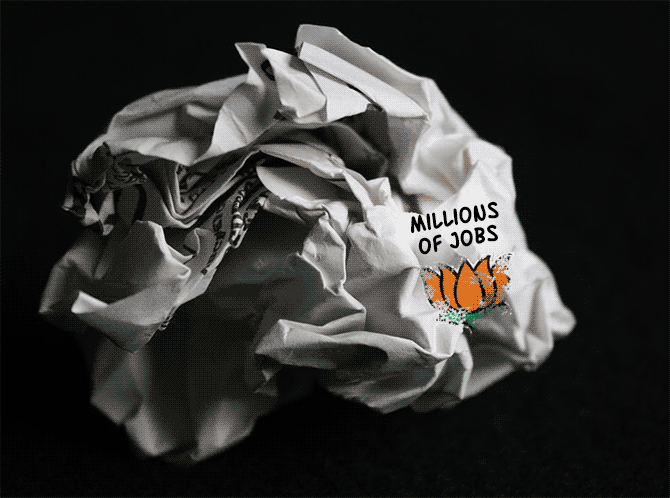Users of employment / unemployment statistics can enjoy the benefits of -- initially the speed of private enterprise and then, the stamp of official statistics with a hopefully small time lag, says Mahesh Vyas.
Illustration: Dominic Xavier/Rediff.com

The government finally released the Annual Report of the Periodic Labour Force Survey (PLFS) 2017-18 and the Quarterly Bulletin PLFS.
The caveat emphasised is that the estimates therein presented in these are not strictly comparable with those obtained by NSSO's Employment and Unemployment Surveys (EUS) conducted earlier.
The differences between the two surveys, as presented in the report, do not make a sufficiently strong case to suggest comparisons would be misleading.
And, the report itself makes plenty of comparisons.
First, the labour force participation rate (LPR) fell below 50 per cent for the first time.
At 49.8 per cent for all people over 14 years of age, it marks a sharp fall from the 64 per cent level in 2004-05.
Male labour participation rate fell from 84 per cent to 76 per cent and from 43 per cent to 23 per cent for females.
The reference period for classifying a person as part of the labour market above is a year.
This is the Usual Status (ps+ss), which is a relaxed definition.
If the reference period is reduced to a week, called the Current Weekly Status (CWS), the LPR drops to 48 per cent; 75 per cent for men and 21 per cent for women.
LPR is the proportion of the adult population that offers itself for employment.
What the official data are telling us is that an increasing proportion of people apparently do not want to work.
This column has chronicled the fall in LPR since demonetisation in November 2016.
We have used CMIE's Consumer Pyramids Household Survey (CPHS) to demonstrate this fall.
This is a good time to compare CPHS estimates with PLFS estimates although there are minor differences in definitions.
The closest comparison can be of the CWS estimates of PLFS with the "Greater" measures of unemployment from CPHS.
We explain the concept of "Greater" below.
CPHS considers only those people to be unemployed who actively seek employment and still do not get employment.
Merely being available for work, but not actively seeking work, is not a sufficient condition to be considered unemployed in the CPHS definition of unemployed.
However, those who are available for work (called "willing to work" in the CPHS parlance) but are not actively looking for employment is also measured separately by CPHS.
If we add the unemployed who are actively looking for employment to those who are willing to work but not actively looking for employment we get what CPHS calls the "Greater Unemployed".
This definition is comparable to the PLFS's definition of the unemployed.
Finally to make appropriate comparisons, we need a matching time reference.
PLFS 2017-18 refers to the period July 2017 through June 2018 when the survey was carried out.
According to CPHS, the comparable labour participation rate during July 2017 - June 2018 was 44.5 per cent (48 per cent PLFS); 73 per cent for men (75 per cent PLFS) and 12.9 per cent for women (21 per cent PLFS).
We believe that female labour participation is much lower than reflected in the PLFS.
The popular unemployment rate quoted from the PLFS is 6.1 per cent.
This is based on the highly relaxed Usual Status definition.
The CWS definition of the PLFS shows the unemployment rate to be much higher at 8.7 per cent.
Rural unemployment rate was 8.4 per cent and urban unemployment rate was 9.5 per cent.
These are very high unemployment rates by any standard.
The comparable CPHS rates were a Greater unemployment rate of 9.1 per cent; rural at 8.6 per cent and urban at 10 per cent.
According to the Quarterly Bulletin, the urban unemployment rate during April-June 2018 was 9.7 per cent.
The comparable estimate from CPHS places this at 9.1 per cent.
In the next quarter, the estimates from PLFS and CMIE are 9.6 per cent and 9.5 per cent, respectively.
And in the October-December 2018 quarter, the estimates from PLFS and CPHS are 9.7 per cent and 10.3 per cent, respectively.
These estimates are close.
CPHS estimates are likely to be more robust than the PLFS estimates because CPHS uses a much larger sample.
PLFS has a sample size of just a shade less than 45,000 households in a quarter.
The CPHS has a sample of about 130,000 households in a quarter.
The PLFS is a rich source of data on employment characteristics in India.
It includes detailed tabulations on employment by status, industry, occupation, conditions of employment, earnings, hours worked, etc.
We look forward to its regular annual release and also to the quarterly releases on the unemployment rate in urban India.
CPHS, it appears, will continue to provide such indicators with much greater speed and based on a much larger sample.
Users of employment / unemployment statistics can enjoy the benefits of -- initially the speed of private enterprise and then, the stamp of official statistics with a hopefully small time lag.











